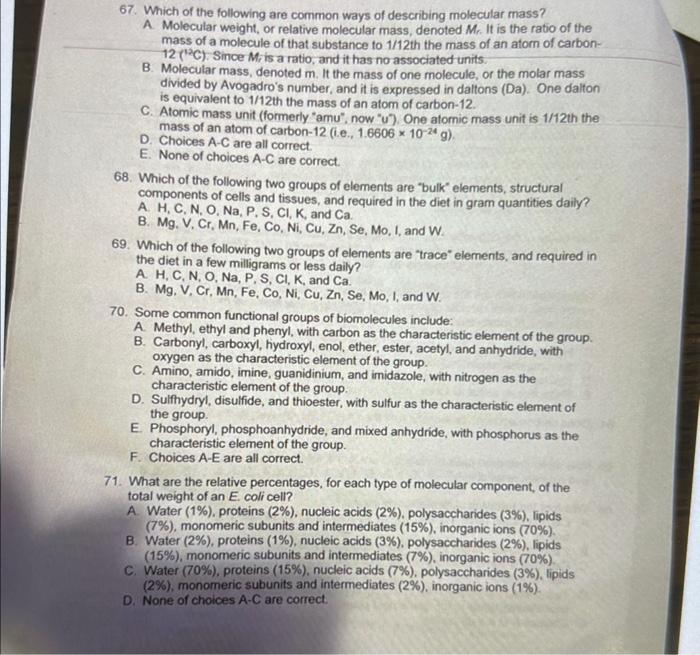please answer all Bio Chem

67. Which of the following are common ways of describing molecular mass? A. Molecular weight, or relative molecular mass, denoted Mr. It is the ratio of the mass of a molecule of that substance to 1/12th the mass of an atorn of carbon12 (12) 12 ). Since Mi is a ratio, and it has no associated units. B. Molecular mass, denoted m. It the mass of one molecule, or the molar mass divided by Avogadro's number, and it is expressed in daltons (Da). One dalton is equivalent to 1/12 th the mass of an atom of carbon-12. C. Atomic mass unit (formerly "amu". now " u ") One atomic mass unit is 1/12th the mass of an atom of carbon-12 (i.e., 1.66061024g ). D. Choices A-C are all correct. E. None of choices A-C are correct. 68. Which of the following two groups of elements are "bulk" elements, structural components of cells and tissues, and required in the diet in gram quantities daily? A. H,C,N,O,Na,P,S,Cl,K, and Ca. B. Mg. V, Cr, Mn, Fe, Co, Ni, Cu, Zn, Se, Mo, I, and W. 69. Which of the following two groups of elements are "trace" elements, and required in the diet in a few milligrams or less daily? A. H,C,N,O,Na,P,S,Cl,K, and Ca. B. Mg,V,Cr,Mn,Fe,Co,Ni,Cu,Zn,Se,Mo,I, and W. 70. Some common functional groups of biomolecules include: A. Methyl, ethyl and phenyl, with carbon as the characteristic element of the group. B. Carbonyl, carboxyl, hydroxyl, enol, ether, ester, acetyl, and anhydride, with oxygen as the characteristic element of the group. C. Amino, amido, imine, guanidinium, and imidazole, with nitrogen as the characteristic element of the group. D. Sulfhydryl, disulfide, and thioester, with sulfur as the characteristic element of the group. E. Phosphoryl, phosphoanhydride, and mixed anhydride, with phosphorus as the characteristic element of the group. F. Choices A-E are all correct. 71. What are the relative percentages, for each type of molecular component, of the total weight of an E. coli cell? A. Water (1%), proteins (2%), nucleic acids ( 2%), polysaccharides (3%), lipids (7%), monomeric subunits and intermediates ( 15%), inorganic ions (70\%). B. Water (2%), proteins ( 1%), nucleic acids ( 3%), polysaccharides (2%), lipids (15%), monomeric subunits and intermediates (7\%), inorganic ions (70%). C. Water (70%), proteins (15%), nucleic acids (7%), polysaccharides ( 3% ), lipids (2\%), monomeric subunits and intermediates (2\%), inorganic ions (1\%). D. None of choices A-C are correct








